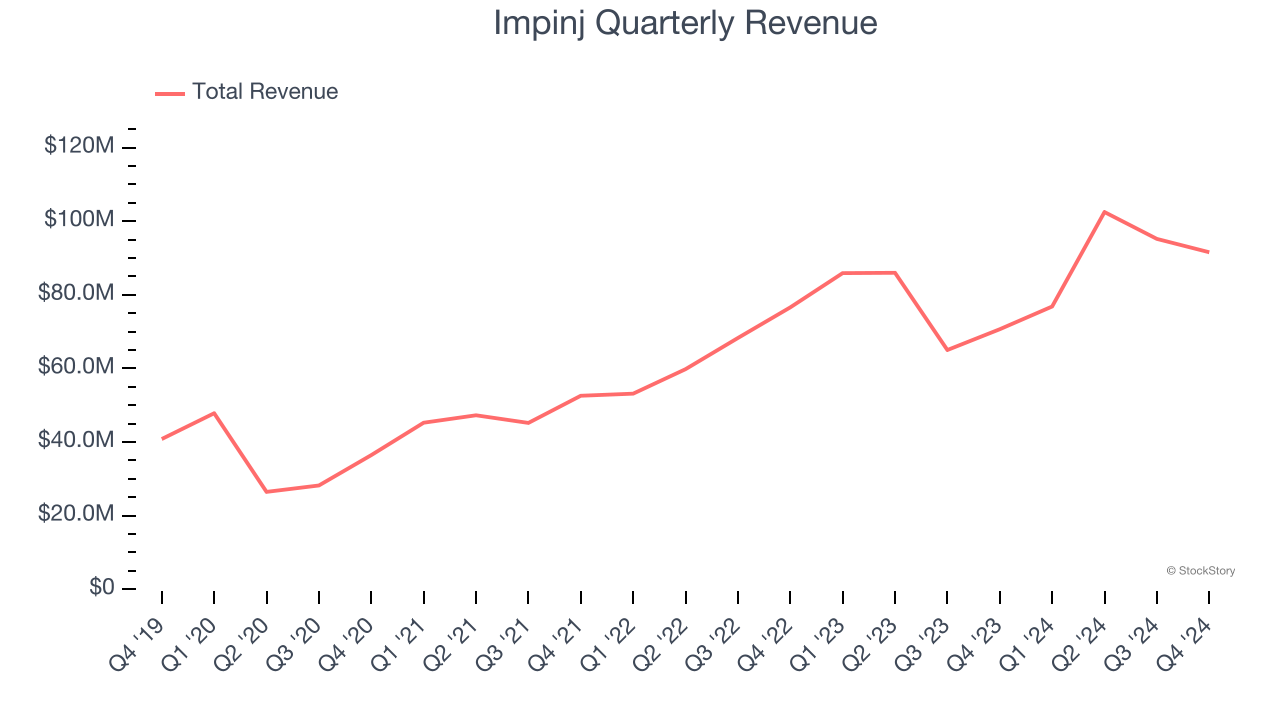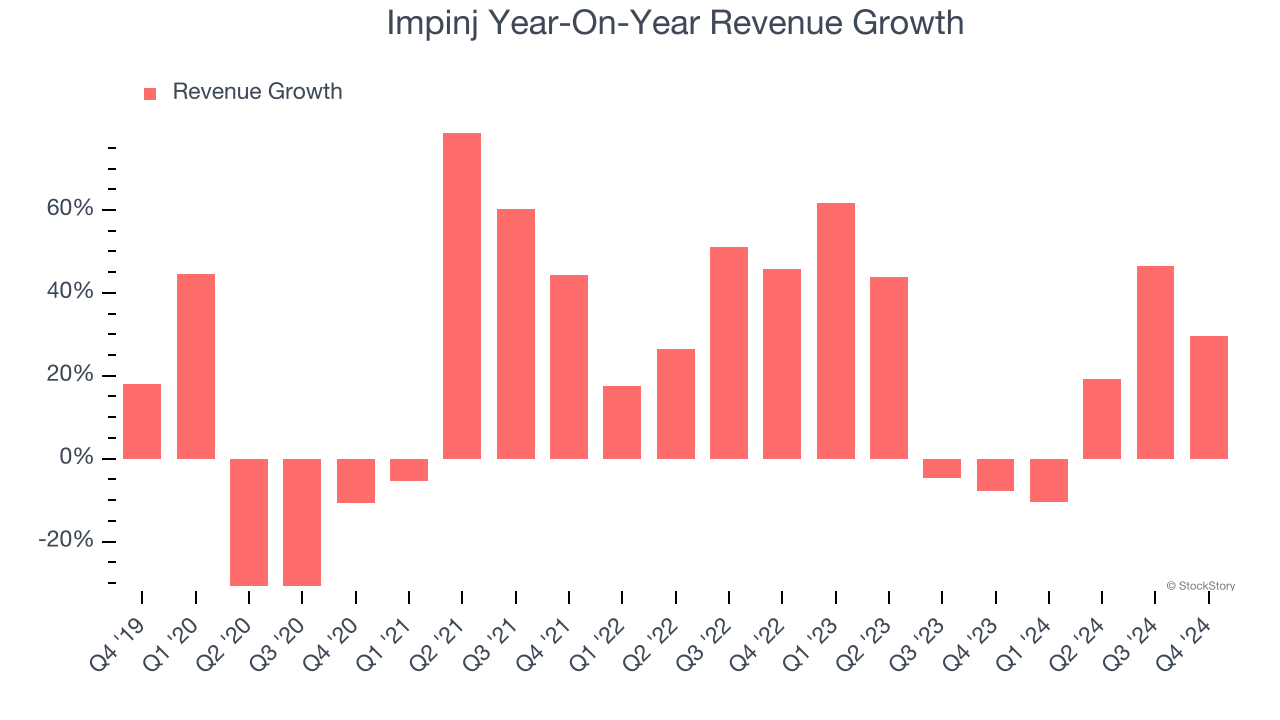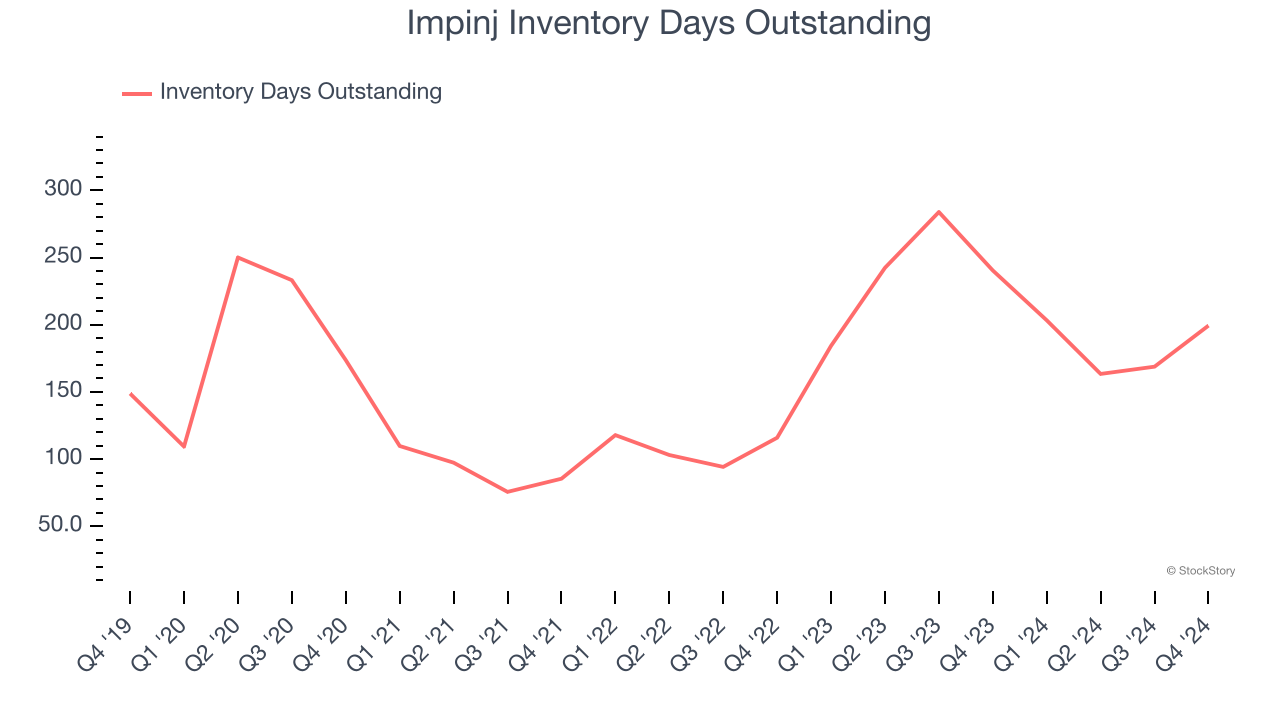
RFID manufacturer Impinj (NASDAQ: PI) missed Wall Street’s revenue expectations in Q4 CY2024, but sales rose 29.6% year on year to $91.57 million. Next quarter’s revenue guidance of $71.5 million underwhelmed, coming in 22.8% below analysts’ estimates. Its non-GAAP profit of $0.48 per share was in line with analysts’ consensus estimates.
Is now the time to buy Impinj? Find out by accessing our full research report, it’s free.
Impinj (PI) Q4 CY2024 Highlights:
- Revenue: $91.57 million vs analyst estimates of $92.83 million (29.6% year-on-year growth, 1.4% miss)
- Adjusted EPS: $0.48 vs analyst estimates of $0.48 (in line)
- Adjusted EBITDA: $15.03 million vs analyst estimates of $15.79 million (16.4% margin, 4.8% miss)
- Revenue Guidance for Q1 CY2025 is $71.5 million at the midpoint, below analyst estimates of $92.6 million
- Adjusted EPS guidance for Q1 CY2025 is $0.08 at the midpoint, below analyst estimates of $0.43
- EBITDA guidance for Q1 CY2025 is $1.85 million at the midpoint, below analyst estimates of $15.17 million
- Operating Margin: -3.9%, up from -21% in the same quarter last year
- Free Cash Flow was $8.49 million, up from -$1.20 million in the same quarter last year
- Inventory Days Outstanding: 199, up from 169 in the previous quarter
- Market Capitalization: $3.58 billion
“In 2024, we delivered strong financial results, successfully resolved our patent litigation and delivered market-leading products and innovations,” said Chris Diorio, Impinj co-founder and CEO.
Company Overview
Founded by Caltech professor Carver Mead and one of his students Chris Diorio, Impinj (NASDAQ: PI) is a maker of radio-frequency identification (RFID) hardware and software.
Analog Semiconductors
Demand for analog chips is generally linked to the overall level of economic growth, as analog chips serve as the building blocks of most electronic goods and equipment. Unlike digital chip designers, analog chip makers tend to produce the majority of their own chips, as analog chip production does not require expensive leading edge nodes. Less dependent on major secular growth drivers, analog product cycles are much longer, often 5-7 years.
Sales Growth
A company’s long-term sales performance signals its overall quality. Even a bad business can shine for one or two quarters, but a top-tier one grows for years. Thankfully, Impinj’s 19.1% annualized revenue growth over the last five years was exceptional. Its growth surpassed the average semiconductor company and shows its offerings resonate with customers, a great starting point for our analysis. Semiconductors are a cyclical industry, and long-term investors should be prepared for periods of high growth followed by periods of revenue contractions (which can sometimes offer opportune times to buy).

We at StockStory place the most emphasis on long-term growth, but within semiconductors, a half-decade historical view may miss new demand cycles or industry trends like AI. Impinj’s annualized revenue growth of 19.2% over the last two years aligns with its five-year trend, suggesting its demand was predictably strong. 
This quarter, Impinj generated an excellent 29.6% year-on-year revenue growth rate, but its $91.57 million of revenue fell short of Wall Street’s high expectations. Company management is currently guiding for a 6.9% year-on-year decline in sales next quarter.
Looking further ahead, sell-side analysts expect revenue to grow 19.5% over the next 12 months, similar to its two-year rate. This projection is noteworthy and indicates the market sees success for its products and services.
Software is eating the world and there is virtually no industry left that has been untouched by it. That drives increasing demand for tools helping software developers do their jobs, whether it be monitoring critical cloud infrastructure, integrating audio and video functionality, or ensuring smooth content streaming. Click here to access a free report on our 3 favorite stocks to play this generational megatrend.
Product Demand & Outstanding Inventory
Days Inventory Outstanding (DIO) is an important metric for chipmakers, as it reflects a business’ capital intensity and the cyclical nature of semiconductor supply and demand. In a tight supply environment, inventories tend to be stable, allowing chipmakers to exert pricing power. Steadily increasing DIO can be a warning sign that demand is weak, and if inventories continue to rise, the company may have to downsize production.
This quarter, Impinj’s DIO came in at 199, which is 37 days above its five-year average, suggesting that the company’s inventory has grown to higher levels than we’ve seen in the past.

Key Takeaways from Impinj’s Q4 Results
We struggled to find many positives in these results. Its revenue guidance for next quarter missed significantly and its revenue fell slightly short of Wall Street’s estimates. Overall, this quarter could have been better. The stock traded down 20.9% to $100.61 immediately following the results.
Impinj didn’t show it’s best hand this quarter, but does that create an opportunity to buy the stock right now? If you’re making that decision, you should consider the bigger picture of valuation, business qualities, as well as the latest earnings. We cover that in our actionable full research report which you can read here, it’s free.





